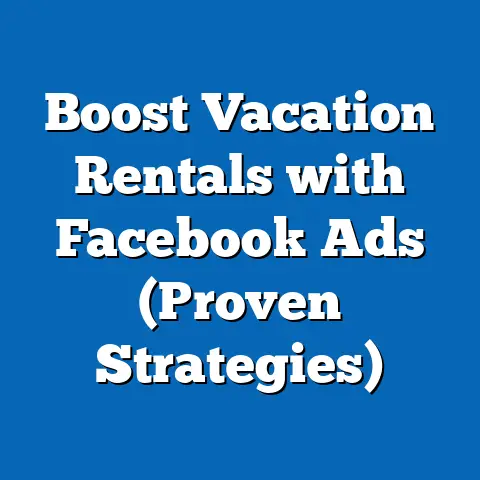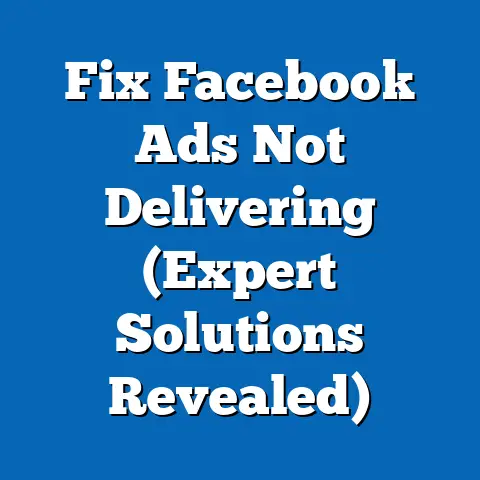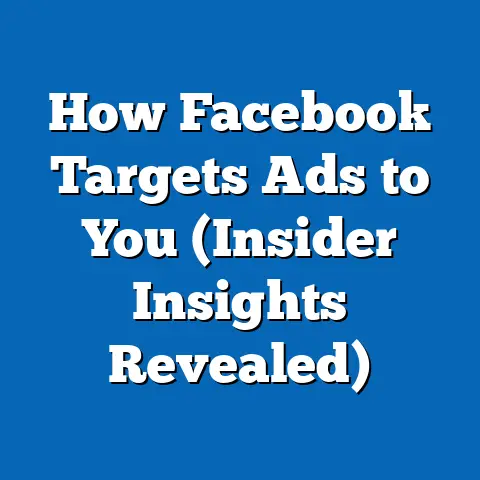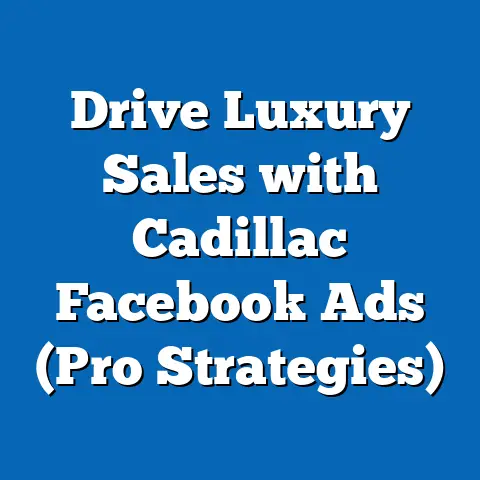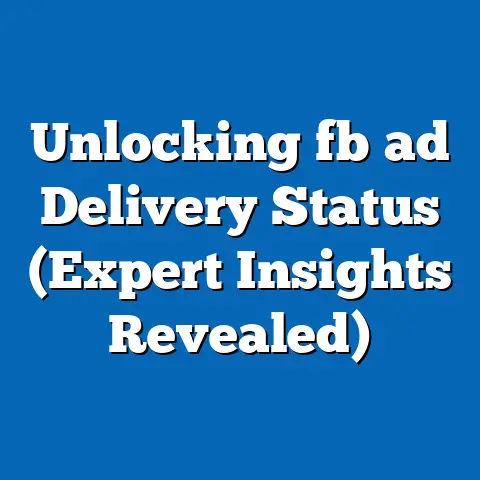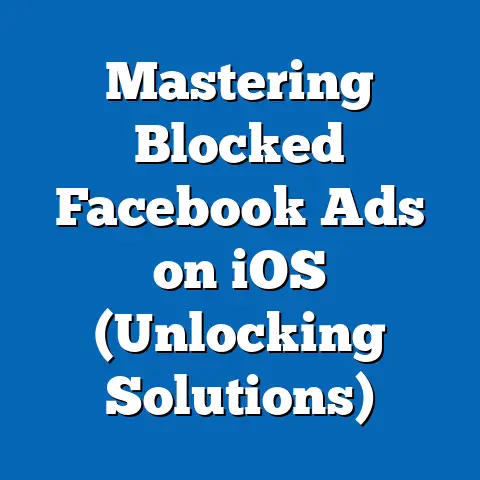Unlock Profitable $5 Facebook Ads (Game-Changing Strategies)
I remember Sarah, a vibrant small business owner I met at a local marketing workshop. She owned a charming little coffee shop, the kind where the aroma of freshly brewed coffee mingled with the chatter of regulars. Sarah had big dreams of expanding her customer base beyond the neighborhood, but the thought of diving into online advertising, particularly Facebook ads, felt like navigating a labyrinth. She’d heard stories of businesses pouring money into campaigns with little to show for it, and frankly, the technical jargon and perceived high costs were enough to keep her on the sidelines.
She confessed to me, scrolling through her phone while sipping her latte, “I just don’t have the budget for those big, fancy ad campaigns. I wish there was a way to reach more people without breaking the bank.”
That’s where the magic of $5 Facebook ads comes in. The truth is, you don’t need a massive budget to see real results on Facebook. With the right strategies and a bit of creativity, even a small investment can unlock significant growth. This article is your roadmap to mastering the art of affordable Facebook advertising. I’ll show you how to leverage the platform’s power, even with a shoestring budget, to reach your target audience, drive conversions, and achieve your business goals. Get ready to discover the game-changing strategies that can transform your marketing efforts, one $5 ad at a time.
Understanding the Facebook Ads Landscape
Facebook ads have come a long way since their humble beginnings. Initially, it was about simply placing ads on the platform. Today, it’s a sophisticated ecosystem where data-driven insights, precise targeting, and creative content converge to deliver impactful results.
The Evolution and Relevance of Facebook Ads
Facebook, now under the Meta umbrella, remains a dominant force in digital marketing. With billions of active users, it offers unparalleled reach and engagement potential. The platform has evolved from basic banner ads to sophisticated, interactive experiences that blend seamlessly into the user’s feed.
I’ve witnessed this evolution firsthand, from the early days of simple text ads to the complex, multi-faceted campaigns we run today. The key is to stay adaptable and embrace the new features and capabilities Facebook continually rolls out.
Why Facebook Remains a Powerful Advertising Platform
Facebook’s strengths as an advertising platform are undeniable:
- Unmatched Targeting: Facebook’s rich data allows you to target your ideal customers with laser-like precision. You can reach people based on demographics, interests, behaviors, location, and even life events. I once used Facebook’s custom audience feature to target customers who had previously purchased a specific product on my website, resulting in a 30% increase in repeat sales.
- Vast User Base: With billions of active users worldwide, Facebook offers unparalleled reach. Whether you’re targeting a niche audience or a broad demographic, you’re likely to find them on Facebook.
- Cost-Effectiveness: While some advertising channels can be prohibitively expensive, Facebook offers a range of bidding options and budget controls that make it accessible to businesses of all sizes. As you’ll discover in this guide, even a $5 daily budget can yield impressive results.
- Diverse Ad Formats: From image and video ads to carousel and collection ads, Facebook offers a variety of ad formats to suit different marketing objectives. This flexibility allows you to experiment and find the formats that resonate best with your audience.
Navigating the Facebook Ads Manager
The Facebook Ads Manager is your central hub for creating, managing, and analyzing your ad campaigns. For newcomers, it can seem a bit daunting, but don’t worry, I’ll break down the essential features:
- Campaign Objective: This is where you define what you want to achieve with your ad campaign, such as driving website traffic, generating leads, or increasing brand awareness.
- Ad Set: Within each campaign, you can create multiple ad sets, each targeting a different audience or using a different bidding strategy.
- Ad: This is the actual ad that users will see, including the ad copy, visuals, and call-to-action.
- Budget and Schedule: Here, you set your daily or lifetime budget and choose when you want your ads to run.
- Targeting: This is where you define your target audience based on demographics, interests, behaviors, and other criteria.
- Placement: You can choose where your ads will appear, such as on Facebook’s News Feed, Instagram, Audience Network, or Messenger.
- Reporting: The Ads Manager provides detailed reports on your ad performance, allowing you to track key metrics and optimize your campaigns.
Key Takeaway: Facebook advertising offers unmatched targeting, reach, and cost-effectiveness. The Ads Manager is your central hub for creating and managing campaigns, and understanding its features is crucial for success.
The $5 Facebook Ad Strategy
Now, let’s dive into the heart of this guide: the $5 Facebook ad strategy. This isn’t about cutting corners or sacrificing quality; it’s about being smart, strategic, and maximizing every dollar you spend.
What is a $5 Facebook Ad?
A $5 Facebook ad is exactly what it sounds like: an ad campaign with a daily budget of just $5. This strategy is ideal for small businesses, startups, or anyone looking to test the waters of Facebook advertising without committing a significant amount of capital.
It’s important to understand that $5 ads aren’t a magic bullet. They require careful planning, precise targeting, and compelling ad creatives to be effective. However, when done right, they can deliver impressive results.
Micro-Targeting: The Key to Maximizing Your Ad Spend
Micro-targeting is the practice of focusing your advertising efforts on a very specific, well-defined audience. This is crucial when working with a limited budget. Instead of casting a wide net, you’re aiming for a small, highly engaged group of people who are most likely to be interested in your product or service.
For example, if you’re selling handmade jewelry, you might target women aged 25-45 who are interested in fashion, crafts, and local boutiques. By narrowing your focus, you can increase the relevance of your ads and improve your click-through rates (CTR) and conversion rates.
Creating Your $5 Ad Campaign: A Step-by-Step Guide
Here’s a step-by-step guide to creating a $5 Facebook ad campaign:
- Define Your Objective: What do you want to achieve with your ad campaign? Do you want to drive website traffic, generate leads, or increase brand awareness? Choose the objective that aligns with your business goals.
- Set Your Budget: Set your daily budget to $5. You can also set a lifetime budget if you want your campaign to run for a specific period.
- Target Your Audience: Use Facebook’s targeting options to define your ideal customer. Consider demographics, interests, behaviors, and location.
- Choose Your Placement: Select the ad placements that are most likely to reach your target audience. For example, if you’re targeting mobile users, you might focus on the Facebook News Feed and Instagram Feed.
- Design Your Ad Creative: Create compelling ad copy and visuals that grab attention and communicate your message effectively. Use high-quality images or videos and include a clear call-to-action.
- Track Your Results: Monitor your ad performance closely and make adjustments as needed. Pay attention to metrics like CTR, CPC, and conversion rate.
Real-World Success Stories
I’ve seen countless examples of businesses that have achieved impressive results with $5 Facebook ads. For instance, a local bakery used a $5 daily budget to promote their new line of gluten-free pastries. By targeting people with gluten sensitivities in their area, they were able to drive a significant increase in foot traffic to their store.
Another example is a small online boutique that sells handmade clothing. They used $5 ads to target fashion-conscious women on Instagram, showcasing their latest designs. This strategy helped them build a loyal following and generate a steady stream of online sales.
Key Takeaway: A $5 Facebook ad strategy is about being smart, strategic, and maximizing every dollar you spend. Micro-targeting, careful planning, and compelling ad creatives are essential for success.
Crafting Compelling Ad Content
Your ad content is the first thing potential customers will see, so it needs to grab their attention and persuade them to take action. This is where creativity, storytelling, and a deep understanding of your target audience come into play.
The Power of Storytelling
People are naturally drawn to stories. They’re engaging, memorable, and can evoke emotions that drive action. Instead of simply listing the features of your product or service, try telling a story that resonates with your target audience.
For example, if you’re selling fitness equipment, you could share the story of a customer who transformed their life through exercise. This is far more compelling than simply listing the specifications of your equipment.
Clear Calls-to-Action (CTAs)
Your ad should always include a clear call-to-action that tells users what you want them to do. Examples include “Shop Now,” “Learn More,” “Sign Up,” or “Get a Free Quote.” Make your CTA prominent and easy to click.
I’ve found that using action-oriented language and creating a sense of urgency can significantly improve CTA performance. For example, “Shop Now and Get 20% Off” is more compelling than simply “Shop Now.”
Eye-Catching Visuals
In today’s visually driven world, your ad visuals are just as important as your ad copy. Use high-quality images or videos that grab attention and communicate your message effectively.
If you’re selling a product, showcase it in an appealing way. If you’re promoting a service, use visuals that convey the benefits of that service.
Examples of Successful Ad Content
Let’s analyze some examples of successful ad content:
- Dollar Shave Club: Their humorous video ads went viral, showcasing their affordable razor subscription service. The key was their relatable humor and clear value proposition.
- Airbnb: Their ads often feature stunning photos of unique accommodations around the world, appealing to travelers’ sense of adventure.
- Nike: Their ads focus on inspiring athletes and promoting a message of empowerment. They often feature famous athletes and motivational slogans.
Key Takeaway: Compelling ad content is essential for success. Use storytelling, clear calls-to-action, and eye-catching visuals to grab attention and persuade users to take action.
Targeting Your Audience Effectively
Targeting is where Facebook advertising truly shines. The platform’s rich data allows you to reach your ideal customers with laser-like precision, ensuring that your ads are seen by the people who are most likely to be interested in your product or service.
Demographics, Interests, and Behaviors
Facebook offers a wide range of targeting options based on demographics, interests, and behaviors. You can target users by age, gender, location, education, relationship status, interests, hobbies, and even their purchase history.
For example, if you’re selling baby products, you might target new parents or expectant mothers. If you’re selling travel packages, you might target people who are interested in travel, adventure, and specific destinations.
Audience Segmentation
Audience segmentation is the practice of dividing your target audience into smaller, more specific groups based on shared characteristics. This allows you to create more relevant and personalized ads that resonate with each segment.
For example, if you’re selling clothing, you might segment your audience by age, gender, and style preferences. You could then create separate ad campaigns for each segment, showcasing the products that are most relevant to their interests.
Lookalike Audiences
Lookalike audiences are a powerful way to expand your reach and find new customers who are similar to your existing customers. Facebook uses its data to identify users who share similar demographics, interests, and behaviors with your current customer base.
This is a great way to reach people who are likely to be interested in your product or service but may not have discovered your business yet.
Facebook Pixel: Retargeting and Conversion Tracking
The Facebook Pixel is a small piece of code that you can install on your website to track visitor behavior. This allows you to retarget visitors who have previously interacted with your website, showing them ads that are relevant to their interests.
For example, if someone visits a specific product page on your website but doesn’t make a purchase, you can retarget them with ads featuring that product, reminding them to complete their purchase.
Key Takeaway: Effective targeting is crucial for success. Use Facebook’s targeting options, audience segmentation, lookalike audiences, and the Facebook Pixel to reach your ideal customers and improve your ad performance.
Analyzing and Optimizing Ad Performance
Once your ad campaigns are up and running, it’s crucial to monitor their performance and make adjustments as needed. This is where data analysis and A/B testing come into play.
Key Performance Metrics (KPIs)
Here are some key performance metrics to track for your Facebook ad campaigns:
- Click-Through Rate (CTR): The percentage of people who see your ad and click on it. A high CTR indicates that your ad is relevant and engaging.
- Cost Per Click (CPC): The amount you pay each time someone clicks on your ad. A low CPC indicates that your ad is cost-effective.
- Conversion Rate: The percentage of people who click on your ad and complete a desired action, such as making a purchase or signing up for a newsletter. A high conversion rate indicates that your ad is driving valuable results.
- Return on Ad Spend (ROAS): The amount of revenue you generate for every dollar you spend on advertising. A high ROAS indicates that your ad campaign is profitable.
A/B Testing: Refining Your Ads
A/B testing is the process of testing different versions of your ads to see which performs best. This can involve testing different ad copy, visuals, calls-to-action, or targeting options.
For example, you could create two versions of your ad with different headlines and see which one generates a higher CTR. Or you could test different images to see which one is more visually appealing.
Actionable Optimization Strategies
Here are some actionable strategies for optimizing your ad campaigns based on data analysis:
- Adjust Your Targeting: If your ads aren’t reaching the right people, refine your targeting options.
- Improve Your Ad Creatives: If your ads aren’t generating enough clicks or conversions, experiment with different ad copy, visuals, and calls-to-action.
- Adjust Your Bidding Strategy: If your CPC is too high, try adjusting your bidding strategy. You can choose between automatic bidding, which lets Facebook optimize your bids, or manual bidding, which gives you more control over your bids.
- Allocate Your Budget Wisely: Focus your budget on the ad sets and campaigns that are performing best.
Key Takeaway: Analyzing and optimizing your ad performance is crucial for success. Track key performance metrics, use A/B testing to refine your ads, and adjust your strategies based on data analysis.
Scaling Your $5 Ads for Maximum Impact
Once you’ve found a winning formula with your $5 Facebook ads, it’s time to think about scaling your campaigns to reach a wider audience and generate even more results. However, it’s important to scale gradually and strategically to avoid wasting money.
Incremental Budget Increases
Instead of dramatically increasing your budget, start with small, incremental increases. For example, you could increase your daily budget by $1 or $2 per day and monitor the results. If you see a positive return on investment, you can continue to increase your budget gradually.
Expanding Audience Reach
Another way to scale your campaigns is to expand your audience reach. You can do this by creating additional ad sets targeting different segments of your audience or by using lookalike audiences to reach new customers who are similar to your existing customers.
Diversifying Ad Formats and Platforms
Consider diversifying your ad formats and platforms to reach a wider audience. For example, you could experiment with video ads, carousel ads, or collection ads. You could also expand your advertising efforts to other platforms, such as Instagram, which is owned by Facebook.
Key Takeaway: Scaling your $5 ads requires a gradual and strategic approach. Start with incremental budget increases, expand your audience reach, and diversify your ad formats and platforms to maximize your impact.
Final Thoughts and Future Trends in Facebook Advertising
The world of Facebook advertising is constantly evolving, with new features, algorithms, and best practices emerging all the time. To stay ahead of the curve, it’s essential to stay informed, experiment with new strategies, and adapt your approach based on the latest trends.
The Importance of Adaptability
Adaptability is key to success in digital marketing. Facebook is constantly changing its algorithms and ad formats, so you need to be willing to adjust your strategies as needed.
I’ve seen countless businesses that have failed to adapt to these changes and have seen their ad performance suffer as a result. The key is to stay curious, experiment with new approaches, and always be learning.
Embrace the $5 Ad Strategy
The $5 Facebook ad strategy is a valuable tool in your marketing arsenal. It allows you to test new ideas, reach a wider audience, and generate leads and sales without breaking the bank.
Don’t be afraid to experiment and see what works best for your business. With a little creativity and strategic thinking, you can achieve impressive results with even a small budget.
The Future of Facebook Advertising
Looking ahead, I see several key trends shaping the future of Facebook advertising:
- Increased Personalization: Facebook will continue to leverage its data to deliver more personalized and relevant ads to users.
- Focus on Video: Video ads will continue to grow in popularity, as they are highly engaging and effective at capturing attention.
- Augmented Reality (AR): AR ads will become more common, allowing users to interact with products and experiences in a more immersive way.
- Artificial Intelligence (AI): AI will play an increasingly important role in ad optimization, helping businesses to automate tasks, improve targeting, and maximize their ROI.
Key Takeaway: The future of Facebook advertising is constantly evolving, so it’s essential to stay informed, experiment with new strategies, and adapt your approach based on the latest trends. Embrace the $5 ad strategy as a valuable tool in your marketing arsenal.

